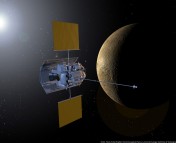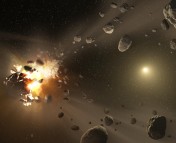Title: Do Metal-rich Stars Make Metal-rich Planets? New Insights on Giant Planet Formation from Host Star Abundances
Authors: Johanna K. Teske, Daniel Thorngren, Jonathan J. Fortney, Natalie Hinkel, John M. Brewer
First Author’s Institution: Observatories of the Carnegie Institution for Science, Pasadena, CA
Status: Accepted for Publication in the Astronomical Journal, preprint on arxiv
A complete, start-to-finish picture of planet formation process continues to elude astronomers. We know that dust grains around young stars collide to form pebble (roughly centimeter) sized bodies. This stage has been observationally confirmed by examining the infrared and radio emission from protoplanetary disks. Beyond this stage, however, the details get less clear. Simple theoretical models predict that bodies larger than pebbles should quickly spiral in and fall onto the host star, due to the aerodynamic drag from the surrounding gas. Even if growing planet-building material can somehow avert this fate, laboratory experiments suggest that it is extremely difficult for any larger bodies to grow further by sticking together. To further complicate matters, bodies larger than pebbles do not emit or reflect very much light, making later stages of planet formation nearly impossible to directly observe.
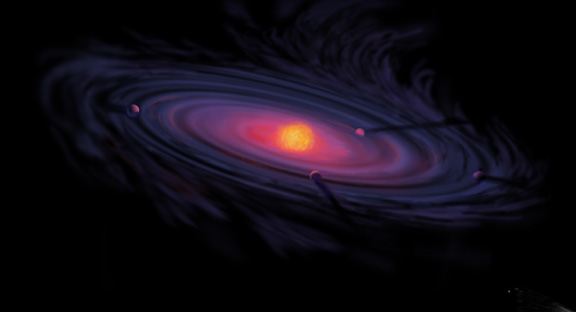
Nevertheless, there is much that can be learned about this complex process by matching observed properties of planets with their host star. One clue that narrows down the possible formation pathways is the fact that gas giant planets are more common around metal-rich stars. This suggests that these planets form by first growing a metal-rich core, which accumulates a gaseous envelope after passing a certain threshold mass. A more metal-rich star generally implies that the protoplanetary disk was also metal-rich. This should therefore allow the core of the planet to form more quickly and efficiently.
Although this trend is broadly true, the details introduce further complications. In particular, the giant planets in the solar system are slightly more metal-rich than the Sun. This suggests that planet-building material might grow in locally concentrated pockets throughout the protoplanetary disk. This explanation conveniently solves some of the problems with the radial drift and growth barriers mentioned above. To shed more light on this process, the authors of today’s paper examine the relation between the metallicity of a number of gas giant exoplanets and their host stars. In doing so, they hope to uncover some additional clues into how these worlds came to be and how these growth barriers are overcome.
Know thy star, and thy planet
Measuring the chemical abundances of stars is fairly straightforward, given a big enough telescope and enough observing time. Stars emit massive amounts of light and their compositions can be determined from absorption lines in their spectrum. Unfortunately, giant planets do not produce enough light to make measurements like this possible. To get around this problem, the authors chose a number of gas giant exoplanets which have reasonably-well measured masses (via radial velocity measurements) and radii (from transit measurements) to study. To figure out the composition of the planets, the authors use a thermal evolution model, which predicts the radius of the planet given a mass and set of chemical abundances. The individual chemical abundances are then tuned until the predicted radius matches observations. In total, these measurements were done for 22 exoplanetary systems. 19 of these also required chemical abundance measurements for the host star, which was done with the Keck, Magellan and Subaru telescopes.
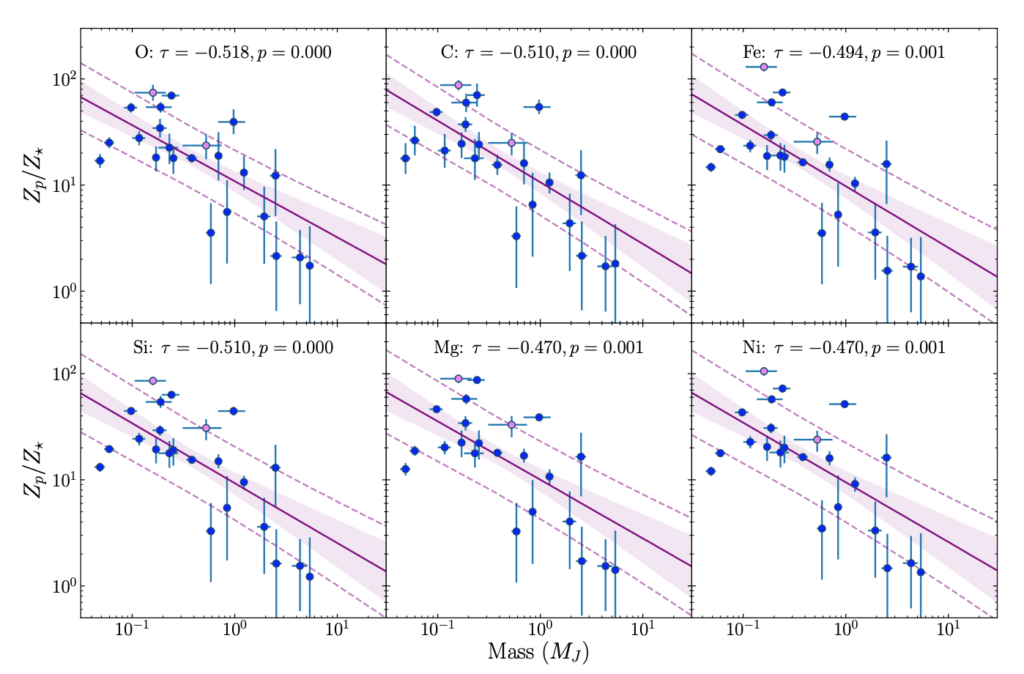
To begin their analysis, the authors compare the calculated chemical abundances of the planets with the masses of the planets. This is shown in figure 2. Using Bayesian analysis, the authors find that more massive planets tend to have lower metallicities, relative to the host star. This can be explained by the core accretion model described above. In this model, the mass required to trigger gas accretion is fairly universal, and so more massive giant planets simply have more hydrogen, which lowers their overall metallicity. It turns out that this anti-correlation between the planet’s mass and metallicity has been previously found. The purpose of doing the analysis here is to ensure that the abundances predicted by the thermal evolution model make sense.
Next, the authors compare the metallicity of the host star to the ‘residual’ abundances of the giant planets. Here, ‘residual’ refers to how much of a given element is present beyond what one would expect from the mass of the planet alone. If a more metal-rich protoplanetary disk produces more metal-rich planets, one would expect a higher fraction of residual metals in planets around metal-rich stars. As shown in figure 3, this, surprisingly, does not appear to be the case. There is no strong correlation between the two quantities.
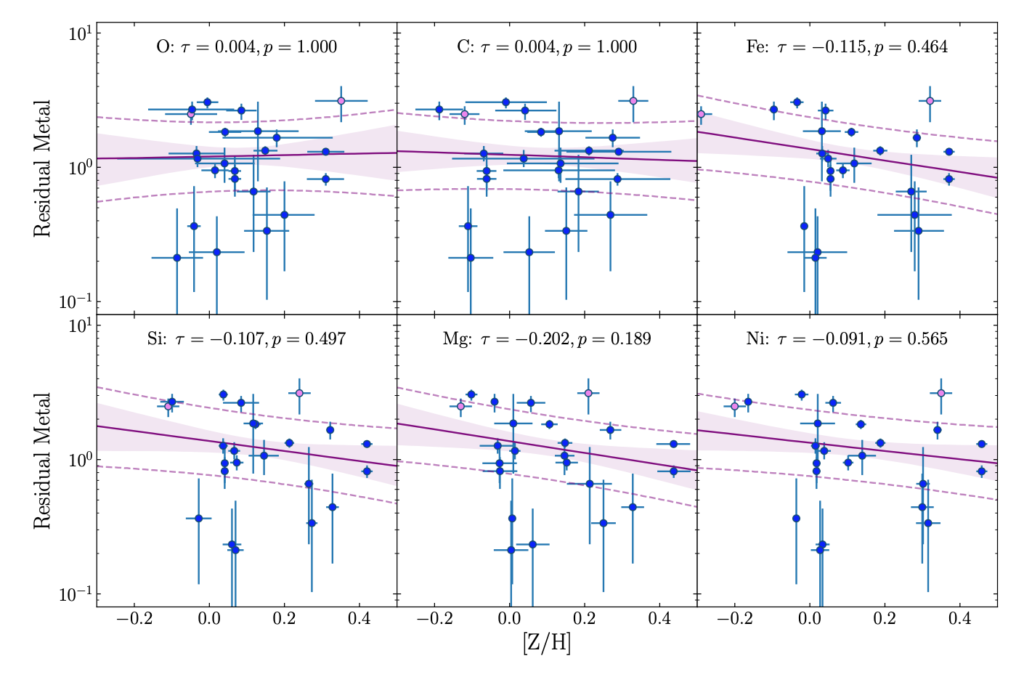
Why no extra metals?
How could one explain this lack of a positive correlation? It’s possible that the the cores of giant planets only form in regions of protoplanetary disks where metals become sufficiently concentrated. This is a particularly attractive explanation, as, again, it would circumvent the growth barriers beyond cm-sized bodies mentioned in the introduction. It might be the case that dust grains and pebbles drift inwards due to gas drag and become trapped in specific regions of the disk. Once the metallicity of these regions passes some threshold, which is independent of the metallicity of the star, the next phase of planet formation suddenly proceeds.
This result is also interesting because it appears to be at-odds with the previously seen correlation between host star metallicity and giant planet occurrence rate. Presumably, there are more giant planets around metal-rich stars because there are more metals available in the disk to form the cores of the planets. But it is possible that this is a false correlation. Stellar metallicity depends on the surrounding galactic environment. Maybe the giant planet occurrence rate is also somehow set by location in the galaxy?
In any case, the lack of correlation between stellar abundance and residual giant planet abundance is surprising and interesting. This lack of a trend can be used as a new constraint on giant planet formation, which theorists will need to work to reproduce in their models. Additionally, it might provide a new clue into how exactly planet building material grows larger than pebbles.

